Updated April 27, 2025
Internet browsers are prone to getting compromised. It can happen by opening an infected e-mail or viewing a malicious ad on a web page. But knowing how to get your browser back to normal is the key. Here's how to clean up and reset Google Chrome.
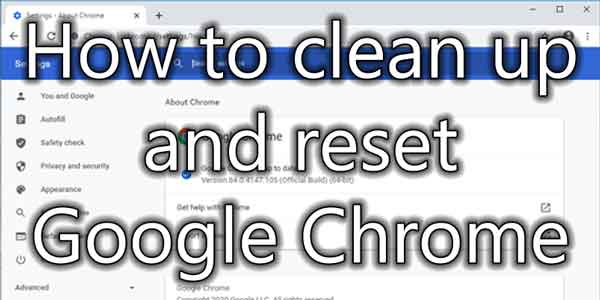
Of the top three (3) browsers out there, Google Chrome is the most popular. One of the main reasons is that to use Google's products, like Google Earth, you have to have Chrome installed. And since it is the most popular, it is also the biggest target for adware and malware. In fact, in the past, the Chrome web store has been compromised with infected apps. Google is now scrutinizing the Chrome extensions harder than ever because of it. So knowing how to clean up and reset Chrome comes in handy.
Cleaning up and resetting Chrome
Google has made resetting the Chrome browser reasonably simple. Just open Chrome and click on the Customize and control button in the upper right-hand corner (it looks like three (3) vertical dots).
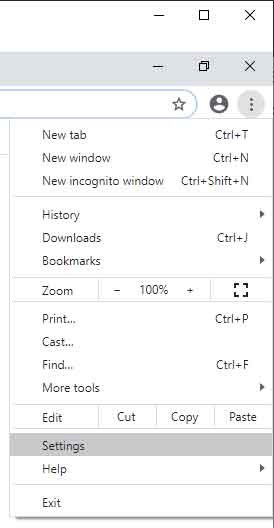
Go down and click on Settings, which will open a page with all user-configurable settings. On the left-hand column, you will find sixteen (16) links: You and Google, Autofill and passwords, Privacy and security, Performance, AI innovations, Appearance, Search engine, Default browser, On startup, Languages, Downloads, Accessibility, System, Reset settings, Extensions, and About Chrome.
The first section is You and Google. This is where you can synchronize Chrome (bookmarks, history, passwords, etc.) across multiple devices. If you are using Chrome on your computer and smartphone, this is a feature you may want to look into.
In this section, you can set up syncing all the different Google services, add a name and picture to your profile, and import bookmarks and settings from other browsers.
The second section is Autofill and passwords and has three (3) categories: Google Password Manager, Payment methods and Address and more. It is here you can choose whether or not to allow Chrome to save passwords, credit cards, and addresses.
Privacy and security is the next section. There are two categories: Safety Check and Privacy and security.
The first category is Safety check. When you click the Go to Safety Check button, Chrome checks for updates, insecure passwords, browsing protection, and harmful extensions.
The second category is Privacy and security and there are six (6) sub-categories: Delete browsing data, Privacy Guide, Third-party cookies, Ad privacy, Security, and Site settings. Let's look at each one separately.
The first category is Delete browsing data and is the first place I go when a customer complains about a website not functioning correctly. There are two categories here: Basic and Advanced.
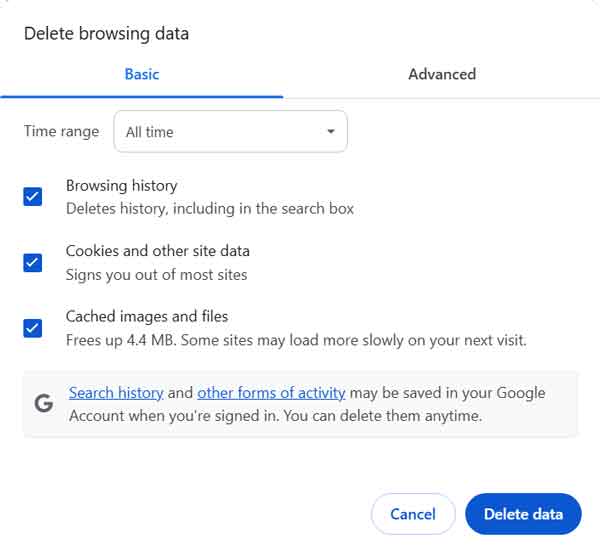
Quite often, selecting the Basic settings with the Time range of All time will do the trick. If that does not fix things, try some of the Advanced options. Do one at a time until Chrome works the way you want.
The second category is the Privacy Guide, which allows you to review key privacy and security controls.
The third category is Third-party cookies. This where you define how Chrome handles cookies. The default setting is to block third-party cookies only when you use incognito mode and be perfectly safe. You can completely block third-party or all cookies if you want, but I recommend turning on the Do Not Track option. Chrome allows you to define which websites can use third-party cookies.
The fourth category is Ad privacy. This is where you can define what info websites can use to display ads. There are three (3) categories: Ad topics, Site-suggested ads, and Ad measurement.
The fifth category is Security, and this is where you define how Chrome displays websites. The default setting for Safe Browsing is Standard protection, which is recommended. You can use the Enhanced protection, but it does send browsing data back to Google. The rest of the default settings are recommended.
The sixth and last category is Site Settings. The default settings are recommended, but you can always modify them to your personal preferences. Some of these settings are in other sections, so don't be surprised if you see a setting you already configured.
The next section is Performance. You can configure various options here, including page preloading and the Memory Saver.
The AI innovations section allows you to configure the various AI settings.
The next section is Appearance, which is more about personalizing Chrome the way you want it to look. Just personal preferences here.
The Search engine section defines what search engine Chrome will use in the address bar.
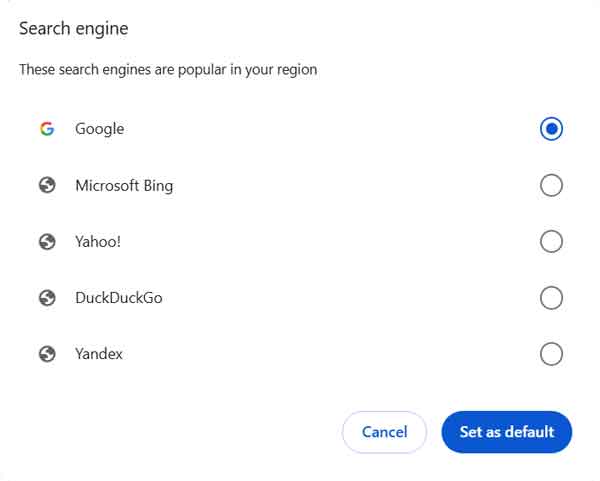
This is one place to check and see if your default search engine in Chrome has been hijacked. If you're not getting the search results you are expecting from the address bar,

more than likely, your default search engine was changed without your knowledge. You can add or remove any of the search engines on this list.
The Default browser section has a link to the Default apps so you can make Chrome your default browser.
The On startup section defines what pages are displayed when Chrome starts up and is one of the first places I look for evidence of browser hijacking. A lot of malicious apps will try and get your browser to automatically open up their website(s) when you start up Chrome. They will also try to take advantage of another setting under System that allows apps to run even without Chrome being open (more on this one later in this article).
If Open a specific page or set of pages is selected, review the pages listed. If there are any page(s) you didn't add yourself, click on the three vertical dots that appear on each page's right-hand side and select Remove. You can also add any page you want to open when you start Chrome here.
The next following (3) sections, Languages, Downloads and Accessibility are for customizing how Chrome works and are more personal preferences. Now when it comes to downloads, I prefer having Chrome ask where I want each file to go before downloading them. Again, personal preference.
The next sections is System. Remember how I told you Chrome could be run without it having to be started? This is where you'll find the setting to turn off this feature. If you are using any Google apps that require Chrome, like Google Docs Offline, you will need to leave the Continue running background apps when Google Chrome is closed selected.
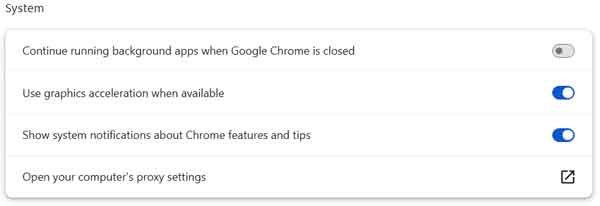
If not, I recommend that you turn this feature off. I've seen adware/malware use this setting to start Chrome when the computer starts up and then controls it remotely. If in doubt, turn it off until a Google app prompts you to enable it.
The next section is Reset settings. The link labeled Restore settings to their original defaults will do just that, reset Chrome back to its default, 'out-of-the-box' setup. It will be just like when you first installed it.
The second to the last section is Extensions. This is where you will find all of the installed apps that run inside Chrome. These extend the functionality and usefulness of Chrome. You'll typically find malicious apps that have installed themselves without your knowledge (usually in kiosk mode). It's here that you can either enable, disable, or remove them from Chrome. If you're unsure about an extension, you can always disable it to find out what it did or didn't do inside Chrome. And when you're sure you don't need it or don't remember installing it, just click the Remove button. If you accidentally remove an extension and want it back, you will have to go through the process of reinstalling it, so be careful.
When you click the Details button for an extension, you will get an option screen. One of the extension options is Allow in incognito for private browsing. Chrome can run in what is called Incognito mode, where it does not save any record of where you have been or what you may have downloaded. If an extension has the option to select Allow in incognito mode, it can be enabled for it. If you use incognito mode, I would defiantly recommend enabling any type of anti-virus, anti-adware, or anti-malware application extension.
The last section is About Chrome and will tell you what version of Chrome you currently have installed and has links to get help, report an issue, and Chrome's privacy policy.
Reinstalling Google Chrome
The last option to get Chrome back to default and work correctly is to uninstall and reinstall it. I only use this option when all else fails to get it back to full functionality. It can take a little time to do, but if you need to get Chrome fully reset, this may be the only option. There are two (2) ways to uninstall programs in Windows; the Settings app or the Control Panel.
Uninstall a program using the Settings app
- Click on the Start
 menu, then Settings (the gear icon), then Apps, then Installed apps.
menu, then Settings (the gear icon), then Apps, then Installed apps.
- Scroll down the list of apps in the right-hand column until you find Google Chrome.
- Highlight Google Chrome and click on the Uninstall button.
Uninstall a program using the Control Panel
- In the search box next to the Start
 button, type Control Panel, and click on it from the results.
button, type Control Panel, and click on it from the results.
- Select Uninstall a program (if viewing by category) or Programs and Features (if viewing by icons).
- Highlight Google Chrome and click on the Uninstall button.
Once Google Chrome is uninstalled, restart your computer. When your computer has rebooted, and you are logged back in, you will need to remove any traces of Google Chrome before reinstalling it. There are two (2) places where you will need to look for any leftover files; inside your user profile and inside the program files directory. The files inside your user profile are hidden by default, but you can get there quickly by bringing up a Run dialog box (Windows Logo key  + R) and typing or copy/paste the following code:
+ R) and typing or copy/paste the following code:
%userprofile%/AppData/Local/Google
This will open the File Explorer to the location of your Google user settings. If there is a folder named Chrome, go ahead and delete it. Next, you will have to navigate to the location of the Program Files directory and check under the folder named Google. Its location is usually C:\Program Files\Google, but it may be different if you installed Google Chrome on a different drive. Once you get there, if you find a folder named Chrome, go ahead and delete it. Now you can download and reinstall Google Chrome.